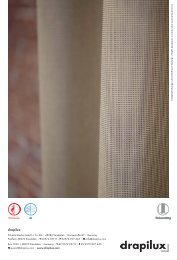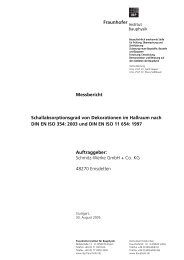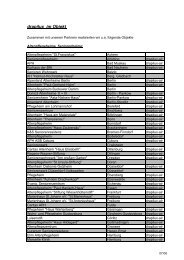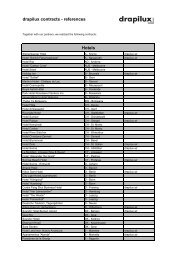Antimicrobial Test Report - Drapilux
Antimicrobial Test Report - Drapilux
Antimicrobial Test Report - Drapilux
Create successful ePaper yourself
Turn your PDF publications into a flip-book with our unique Google optimized e-Paper software.
<strong>Antimicrobial</strong> <strong>Test</strong> <strong>Report</strong><br />
Customer: Schmitz via: BST<br />
<strong>Report</strong> date: 03. September 2010<br />
<strong>Report</strong> number: BT10-0102 Internal reference: TS10-0121<br />
Short Description: 2-step application: Curtain fabric treated with Pure by HeiQ ® and Air by Schmitz.<br />
<strong>Test</strong>ing antimicrobial activity against MRSA.<br />
1 Sample Description<br />
Sample Details: Curtain fabric, PET Trevira CS, mesh like<br />
Sample Preparation: Application by customer Application by HeiQ<br />
Mill trial<br />
Laboratory<br />
Treatment:<br />
HeiQ AGS-20 TF (antimicrobial textile finish)<br />
Standard formulation ‡<br />
HeiQ AGS-20 TF: g/L<br />
Superior Durability formulation ‡<br />
HeiQ AGS-20 TF: 30 g/L<br />
HeiQ AGS-20 SD: 15 g/L<br />
at pick-up 30 %<br />
‡ Refer to HeiQ AGS-20 TF Technical Datasheet for further details<br />
Handling:<br />
HeiQ AGS-20 MB (antimicrobial masterbatch)<br />
Silver dosing range: up to ppm Ag<br />
HeiQ AGS-20 powder<br />
Loading range: up to % HeiQ AGS-20 (up to ppm Ag)<br />
Other:<br />
2. process step after Pure: Air product 120 g/l, PU-DM 10 g/l,<br />
AGS-20 SD 10 g/l<br />
<strong>Test</strong>ed as received<br />
Laundry testing (ISO 6330). Up to x at °C.<br />
Other:<br />
2 Method<br />
Method Type:<br />
ISO 20743 / JIS L 1902 (Textiles and absorbent articles)<br />
ISO 22196 / JIS Z 2801 (Plastics, coatings and non-absorbent articles)<br />
Other:<br />
<strong>Test</strong> Organisms: Klebsiella pneumoniae (ATCC 4352)<br />
Escherichia coli (ATCC 8739)<br />
Staphylococcus aureus (ATCC 6538P)<br />
Other: Methicillin-resistant Staphylococcus aureus (NCTC 8325 mec)<br />
3 Notes<br />
See appendix for details of test method and organisms<br />
• When reviewing the following results tables please note the following:<br />
o “cfu” is an abbreviation for colony forming units.<br />
o The detection limit for bacteria count is 9.9 x10 1 cfu.<br />
o Numbers in table are given in scientific notation (eg. 2.4E+05 indicates 2.4 x10 5 ).<br />
Continued overleaf.<br />
CONFIDENTIAL<br />
Zürcherstrasse 42, CH-5330 Bad Zurzach, Switzerland Tel: +41(0)56 250 68 50 Fax: +41 (0)56 250 68 51 1/3
4 Results<br />
Reference Material(s): HeiQ reference polyester (0912)<br />
HeiQ reference cotton (0994)<br />
As listed in results table(s)<br />
MRSA (Staphylococcus aureus, NCTC 8325 mec)<br />
# ID Sample<br />
Bacteria count (cfu)<br />
Mean<br />
St.Dev<br />
%<br />
reduction<br />
Log<br />
reduction Performance<br />
- 0912 HeiQ reference polyester (0 hrs) 7.2E+04 1.1E+04 - - -<br />
- 0912 HeiQ reference polyester 4.3E+06 8.5E+05 - - -<br />
1 BT10-0102-001 Treated curtain fabric, unwashed 9.9E+01 0.0E+00 99.998% 4.6 Very good<br />
5 <strong>Test</strong> Comments<br />
5.1 Control validity • Controls OK. No inherent antimicrobial activity.<br />
5.2 Sample comments • No comments.<br />
6 Remarks<br />
• Treated curtain fabric shows very good antimicrobial activity against MRSA.<br />
Dr. Rainer Lehmann<br />
Institute of Food Science and Nutrition<br />
Swiss Federal Institute of Technology (ETH Zürich)<br />
Mr. Martin Meyer<br />
Customer Service<br />
HeiQ Materials<br />
Dr. Murray Height<br />
Chief Technology Officer<br />
HeiQ Materials<br />
HeiQ Materials AG<br />
Zürcherstrasse 42<br />
CH-5330 Bad Zurzach, Switzerland<br />
Office +41 (0)56 250 68 50<br />
Fax +41 (0)56 250 68 51<br />
info@heiq.com<br />
www.heiqmaterials.com<br />
CONFIDENTIAL<br />
2/3
APPENDIX: <strong>Antimicrobial</strong> <strong>Test</strong> Methods:<br />
1 General<br />
• HeiQ offers a range of microbiological test services through our partner laboratory at the Swiss Federal Institute of Technology (ETH Zürich).<br />
• The intended purpose of the test service is to provide rapid and low-cost performance feedback to aid customer product development.<br />
• For final certification of product antimicrobial performance HeiQ can put the customer in touch with suitable independent laboratories that can<br />
provide this service.<br />
2 Quantitative <strong>Test</strong>s<br />
• Quantitative test methods are used routinely for evaluating the performance of product treated with antimicrobial agents and there are various<br />
standard methods available for this purpose.<br />
• Each quantitative method involves the following basic steps:<br />
1. Sterilize the sample(s) to remove any ambient organisms or contaminants.<br />
2. Apply a known number of a target bacteria strain to each sample.<br />
3. Maintain sample(s) at temperature to allow the bacteria to grow.<br />
4. After a fixed time, extract and count the bacteria remaining on each sample.<br />
5. Compare the remaining bacteria between each treated sample and an un-treated control to assess the antimicrobial performance<br />
resulting from the treatment.<br />
2.1 Absorbant Samples (eg. textiles, fabrics, fibers, nonwovens etc.)<br />
• Method based on Japanese Industrial Standard JIS L 1902.<br />
• Prepare sample test pieces of ca.0.4g, repeated in triplicate<br />
• Samples sterilized either with steam treatment (steam @100°C for 5 minutes, drying @70°C for max. 5 hours) or 70% ethanol solution rinse.<br />
• Prepare bacteria culture of ca. 1 x10 6 cells/ml<br />
o Typically only Klebsiella pneumoniae is used in a first test series.<br />
• 200 µl of bacteria culture applied to sample<br />
• Sample incubated for 18 hours at 37 °C<br />
• Living bacteria remaining on each sample are rinsed off and counted. Counting provides the number of so-called Colony Forming Units (cfu)<br />
which is an indicator of bacteria population.<br />
• Calculation of antimicrobial performance metrics (From cfu counts after 18 hrs). See metric calculations below.<br />
2.2 Non-Absorbant Samples (eg. plastics, films, painted surfaces etc.)<br />
• Method based on Japanese Industrial Standard JIS Z 2801.<br />
• Sample geometry 5cm x 5cm (or equivalent area).<br />
• Samples sterilized with 70% ethanol solution.<br />
• Prepare bacteria culture of ca. 10 6 cells/ml.<br />
o Typically only Escherichia coli is used in a first test series.<br />
• 400 µl of bacteria culture applied to sample surface.<br />
• Clear plastic sheet 4cm x 4cm (or equivalent area) applied to spread inoculum volume over sample surface.<br />
• Sample incubated for 24 hours at 37 °C in a humidity chamber.<br />
• Living bacteria remaining on each sample are rinsed off and counted. Counting provides the number of so-called Colony Forming Units (cfu)<br />
which is an indicator of bacteria population.<br />
• Calculation of antimicrobial performance metrics (From cfu counts after 24 hrs). See metric calculations below.<br />
3 <strong>Antimicrobial</strong> Performance Metrics<br />
• <strong>Antimicrobial</strong> performance metrics calculated from the mean cfu counts as follows.<br />
% Reduction =<br />
[(Mean cfu) control - (Mean cfu) sample]<br />
(Mean cfu) control<br />
Log reduction = Log 10(Mean cfu) control - Log 10(Mean cfu) sample<br />
• HeiQ assigns antimicrobial performance categories according to the following table.<br />
4 Bacteria Strains<br />
x 100<br />
<strong>Antimicrobial</strong> performance Log reduction % Reduction<br />
None






